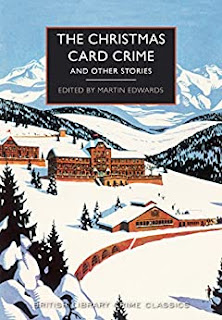Solving a seemingly impossible murder
 |
| Dickson's story appears in the collection A Surprise for Christmas |
Persons or
Things Unknown was written by one of only two American writers admitted to the
prestigious British Detection Club, Carter Dickson, who was much admired by his
fellow Golden Age writers for his locked room mysteries.
Carter
Dickson was one of the pen names for John Dickson Carr, who lived in England and
wrote most of his novels and short stories with English settings. He wrote
Persons or Things Unknown for The Sketch, a weekly illustrated journal, for
their Christmas edition in 1938.
Dickson
served up a locked room mystery in a spooky setting with a historical
background, which is perfect entertainment for whiling away an afternoon in
December or January in front of a fire as a guest in someone’s unfamiliar, and
not particularly comfortable, house.
Persons or
Things Unknown has the reign of King Charles II as its background. When it was
written, it was far less common to combine mystery with history, particularly
in short story form, than it is now.
 |
| John Dickson Carr wrote under a number of pseudonyms |
One of the
guests, who narrates the story, tells us that the smell of the past was in the
house and that you could not get over the idea that ‘someone was following you
about.’
The host alarms
the group of guests by saying he wants to know if it is safe for anyone to
sleep in the little room at the top of the stairs. He says he has ‘a bundle of
evidence’ about ‘something queer’ that once happened in the room.
He then
tells them he has been given a diary in which the writer says he once saw a man
hacked to death in the little room at the top of the stairs. The man’s body is
alleged to have had 13 stab wounds caused by ‘a weapon that wasn’t there, which
was wielded by a hand that wasn’t there’.
The diary tells
the story of the beautiful young daughter of the house, who was once engaged to
a local landowner. Then along came a fashionably dressed young man from the
court of the newly restored King Charles II, who fell for her and was determined to win her hand
in marriage. The subsequent dramatic events led to a seemingly impossible
murder in the little room at the top of the stairs, which used to be called The
Ladies’ Withdrawing Room. It was a mystery that no one had ever been able to
solve.
The host
then puts all the facts he has been able to discover before his guests, who
include a policeman and an historian, and invites them to come up with a
solution.
 |
| The Hollow Man is regarded as Dickson Carr's masterpiece |
Most of his
novels had English settings and English characters and his two best-known
fictional detectives, Dr Gideon Fell and Sir Henry Merrivale, were both
English. He is regarded as one of the greatest writers of Golden Age mysteries.
He was influenced by his enthusiasm for the stories of Gaston Leroux and became
a master of the locked room detective story in which a seemingly impossible
crime is solved. His 1935 Dr Fell mystery, The Hollow Man, is considered his
masterpiece and was selected as the best locked room mystery of all time in
1981 by a panel of 17 mystery authors and reviewers.
Persons or
Things Unknown was republished by the British Library in 2020 in A Surprise For
Christmas, a collection of seasonal mysteries selected by the crime writer Martin
Edwards.
In his
introduction to Persons or Things Unknown, Edwards says the author ‘blends
historical atmosphere with a pleasing locked room mystery in the form of an
inverted detective story of the kind first popularised by R. Austin Freeman.’
In my
opinion, this pleasing locked room mystery by Carter Dickson, which takes up
just 20 pages of the book, would be the perfect post lunch, or post dinner, winter
diversion.
Buy A Surprise for Christmas from or




